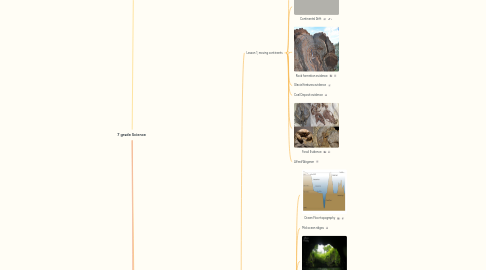
1. Unit 1, understanding Matter
1.1. Module 1, Classification and States of Matter
1.1.1. Lesson 1, Energy and States of Matter
1.1.1.1. Matter
1.1.1.2. Solid State
1.1.1.3. Liquid State
1.1.1.4. Gas State
1.1.1.5. Kinetic Energy
1.1.1.6. Temperature
1.1.1.7. Thermometer
1.1.1.8. Kelvin Scale
1.1.1.9. Potential Energy
1.1.1.10. Thermal Energy
1.1.1.11. Atoms
1.1.1.12. Substances
1.1.1.13. Elements
1.1.1.14. Compound
1.1.1.15. Molecule
1.1.1.16. Periodic Table of Elements
1.1.1.17. Element Symbols
1.1.1.18. Chemical Formula
1.1.2. Lesson 2, changes in temperature
1.1.2.1. Jacques Charles
1.1.2.2. Volume Temperature Law
1.1.2.3. Thermal Contraction
1.1.2.4. Thermal expansion
1.1.2.5. Systems
1.1.2.6. Heating
1.1.2.7. Pressure
1.1.2.8. Phase Change
1.1.2.9. Melting
1.1.2.10. Freezing
1.1.2.11. Condensation
1.1.2.12. Vaporization
1.1.2.13. Boiling vs. Evaporation
1.1.3. Lesson 3, changes in pressure
1.1.3.1. Robert Boyle
1.1.3.2. Boyles Law - Pressure and Volume
1.1.3.3. Boyles Law - Number of particles
1.1.3.4. Boyles Law - Pressure and States of matter
1.1.4. Lesson 4, molecular structure
1.1.4.1. Molecule
1.1.4.2. Nonmetal Gases
1.1.4.3. Nonmetal solids
1.1.4.4. Metal
1.1.4.5. Ionic compounds
1.1.4.6. Covalent compounds
1.1.4.7. Polar covalent compounds
1.1.4.8. Nonpolar covalent compounds
1.1.4.9. Dissolving
1.2. Module 2, Matter: Properties and Changes
1.2.1. Lesson 1, Properties of Matter
1.2.1.1. Qualitative Characteristics
1.2.1.2. Quantitative Characteristics
1.2.1.3. Mass
1.2.1.4. Weight
1.2.1.5. Volume
1.2.1.6. Density
1.2.1.7. Chemical Properties
1.2.1.8. Flammability
1.2.1.9. Oxidation
1.2.1.10. Reactivity
1.2.1.11. Solubility
1.2.2. Lesson 2, Properties Changes in Chemical reactions
1.2.2.1. Chemical Changes
1.2.2.2. Chemical Reactions
1.2.2.3. Chemical Equations
1.2.2.4. Products
1.2.2.5. Reactants
1.2.2.6. Coefficients
1.2.2.7. Antoine Lavoisier
1.2.2.8. Law of conservation of mass
1.2.2.9. Atomic Mass
1.2.3. Lesson 3, energy changes in chemical reactions
1.2.3.1. Chemical Potential Energy
1.2.3.2. Endothermic Reaction
1.2.3.3. Exothermic Reaction
1.2.3.4. Concentration in reactions
1.2.3.5. Law of conservation of energy
2. Unit 2, the changing Earth
2.1. Module 1, dynamic Earth
2.1.1. Lesson 1, moving continents
2.1.1.1. Pangea
2.1.1.2. Continental Drift
2.1.1.3. Rock formation evidence
2.1.1.4. Glacial features evidence
2.1.1.5. Coal Deposit evidence
2.1.1.6. Fossil Evidence
2.1.1.7. Alfred Wegener
2.1.2. Lesson 2, development of a theory
2.1.2.1. Ocean Floor topography
2.1.2.2. Mid ocean ridges
2.1.2.3. Ocean trenches
2.1.2.4. Isochron Maps
2.1.2.5. Seafloor spreading
2.1.2.6. Magma
2.1.2.7. Lava
2.1.2.8. Plate Tectonics
2.1.3. Lesson 3, shaping Earth's surface
2.1.3.1. Convergent Boundary
2.1.3.2. Divergent Boundary
2.1.3.3. Transform Boundary
2.1.3.4. Subduction
2.1.3.5. Fault
2.1.3.6. Fault Block Mountains
2.1.3.7. Volcano
2.1.3.8. Volcanic Arc
2.1.3.9. Earthquake
2.1.3.10. Fault Zone
2.1.3.11. Landslide
2.1.3.12. Tsunami
2.1.3.13. Impact Crater
2.1.4. Lesson 4, changing Earth's surface
2.1.4.1. Physical Weathering
2.1.4.2. Frost Wedging
2.1.4.3. Plant Action
2.1.4.4. Abrasion
2.1.4.5. Wind Abrasion
2.1.4.6. Water Abrasion
2.1.4.7. Glacial Abrasion
2.1.4.8. Chemical Weathering
2.1.4.9. Oxidation
2.1.4.10. Hydrolysis
2.1.4.11. Carbonation
2.1.4.12. Erosion
2.1.4.13. Deposition
2.1.4.14. Small Scale Erosion
2.1.4.15. Surface runoff
2.1.4.16. Coastal Erosion
2.1.4.17. Large Scale Erosion
2.1.4.18. Mass Wasting
2.1.4.19. Glacial Movement
2.1.5. Lesson 5, the cycling of Earth's Materials
2.1.5.1. Rock
2.1.5.2. Mineral
2.1.5.3. Crystallization
2.1.5.4. Igneous extrusive rock
2.1.5.5. Igneous intrusive rock
2.1.5.6. Sedimentary rock
2.1.5.7. Lithification
2.1.5.8. Compaction
2.1.5.9. Cementation
2.1.5.10. Metamorphic rock
2.2. Module 2, natural hazards
2.2.1. Lesson 1, Earthquakes
2.2.1.1. Richter Magnitude scale
2.2.1.2. Earthquakes and plate boundaries
2.2.1.3. Earthquake magnitude scale
2.2.1.4. Moment magnitude scale
2.2.1.5. Modified Mercalli intensity scale
2.2.1.6. Pancaking
2.2.1.7. Liquefaction
2.2.1.8. Landslide
2.2.1.9. Tsunami
2.2.2. Lesson 2, volcanoes
2.2.2.1. Volcano Belts
2.2.2.2. Hot Spots
2.2.2.3. Mudflows
2.2.2.4. Lava flows
2.2.2.5. Volcanic Ash
2.2.2.6. Volcanic Gases
2.2.2.7. Pyroclastic Flows
2.2.2.8. Predicting volcanoes - Gas
2.2.2.9. Predicting volcanoes - Deformation
2.2.2.10. Predicting volcanoes - Ground Vibration
2.2.2.11. Predicting volcanoes - Remote Sensing
2.2.2.12. Predicting volcanoes - Lava Collection
2.2.3. Lesson 3, severe weather
3. Unit 3, the Earth's Resources
3.1. Module 1, distribution of Earth's resources
3.1.1. Lesson 1, natural resources
3.1.2. Lesson 2, distribution of resources
3.1.3. Lesson 3, depletion of resources
3.2. Module 2, materials science
3.2.1. Lesson 1, synthetic technology
3.2.2. Lesson 2, synthetic materials and societal impacts
4. Unit 4, interactions with Ecosystems
4.1. Module 1, matter and energyin Ecosystems
4.1.1. Lesson 1, photosynthesis and cellular
4.1.2. Lesson 2, flow of Energy
4.1.3. Lesson 3, Cycling of matter
4.2. Module 2, Dynamic Ecosystems
4.2.1. Lesson 1, resources in Ecosystems
4.2.2. Lesson 2, interactions within Ecosystems
4.2.3. Lesson 3, changing Ecosystems
